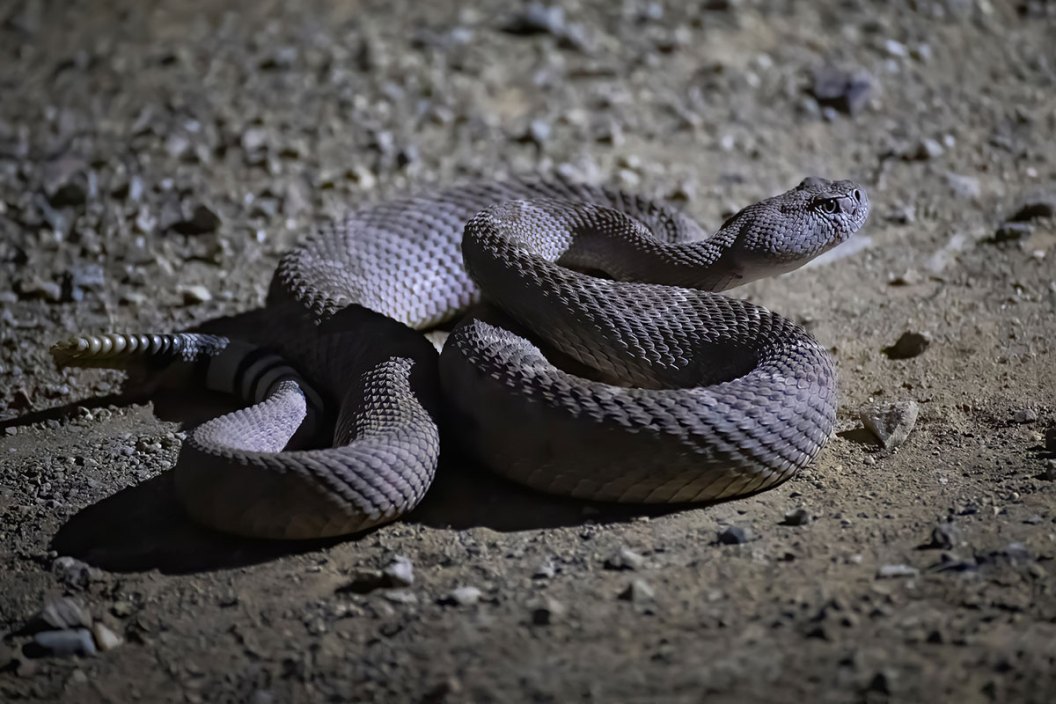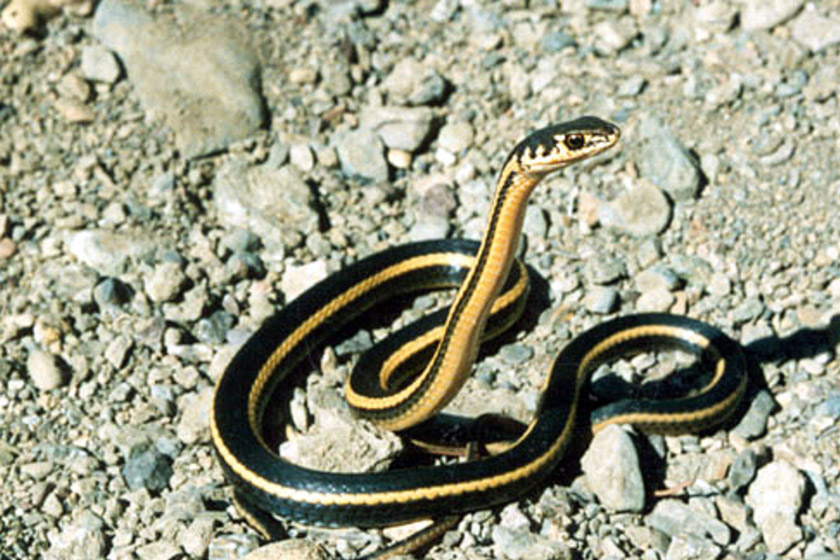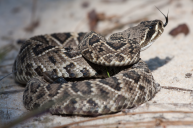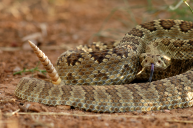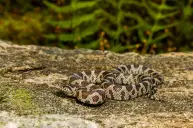The sunny state of California is full of critters, among them slithery snakes. The variety among California's snakes is wide; even the same species can have several colorations, blotches on their reptile skin, and vary between venomous snakes and their non-lethal cousins. California is a big place and snakes are found from Baja California to Northern California and everywhere in between. As hikers, campers, hunters, and outdoorsmen it is important to know what we are looking at while out in the woods. Let's break down species identification and potential dangers with snake encounters. California has a lot of snake species, but the following nine are considered to be the most common, according to California Herps.
Common Snakes Found in California

Getty: Mark Kostich
- Gopher snake
- Coachwhip (Racer)
- Sharp-tailed snake
- California kingsnake
- Western yellow-bellied racer
- Striped Racer (Whipsnake)
- Ring-necked snake
- Garter snake
- Western rattlesnake
Gopher Snake
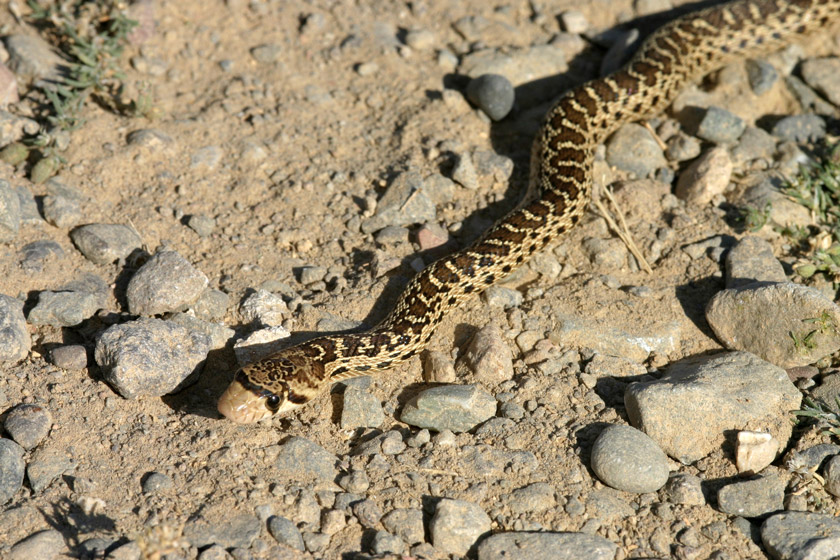
Getty: matsf
Gopher snakes are one of the most common nonvenomous snakes of California and are found throughout the state, with higher concentrations in the southern portions of the state. Gopher snakes prefer semi-arid areas, including flat plains with bits of brushy cover. They are a common find in agricultural settings.
They are sometimes mistaken for rattlesnakes because they hiss or shake their tail when they feel threatened, similar to a rattlesnake. Colorization is usually green, brown, or yellow, with spots and mottles all down their backs.
These snakes are mainly active during the day, but are also active after sundown on hot days. Gopher snakes are often seen in suburban settings since they are active predators of the same rodents that can plague those areas. Their diet consists of mostly small rodents, such as gophers, but they've also been known to eat birds, eggs, lizards, and even bats. They're often dinner for foxes, red-tailed hawks, and coyotes, none of which are deterred by their rattlesnake impression.
Gopher snakes include the Sonoran gopher snake, San Diego gopher snake, Pacific gopher snake, Great Basin gopher snake, and the Santa Cruz Island gopher snake. They are sometimes referred to as bullsnakes.
Coachwhip
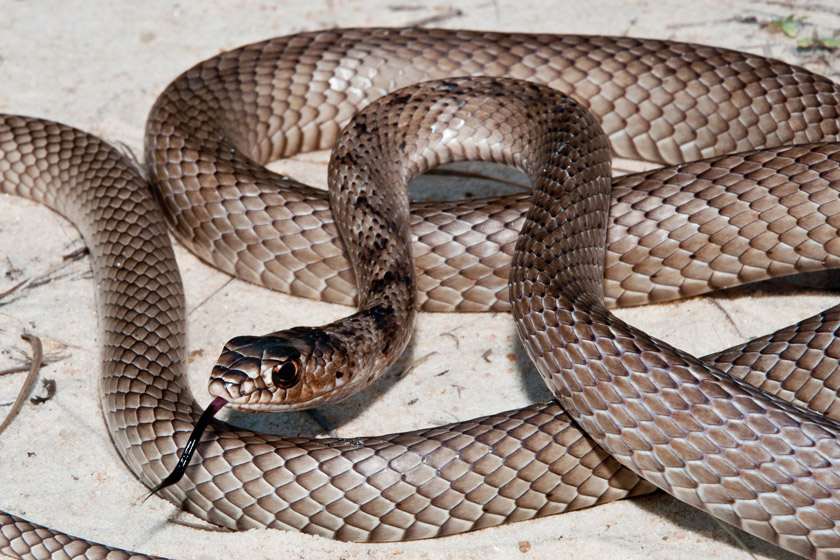
Getty: JasonOndreicka
Another nonvenomous snake is the Coachwhip (commonly identified as a racer) which is a fast-moving snake found in open arid areas. It has multiple color variations including tan, brown, black, or reddish-colored along with an irregular blotching on the neck.
Coachwhips are long, slender, fast-moving snakes of open, hot, dry areas. Colorization varies. They can be tan, silver, brown, reddish, or black, with irregular blotches or bands and black on the neck. Coachwhip tails are very long and thin and appear braided, like a whip.
Coachwhips include the Baja California coachwhip, red coachwhip, and the San Joaquin coachwhip. The Baja coachwhip is very rarely observed in extreme southern San Diego County, the San Joaquin coachwhip is threatened in the Central Valley, having lost much of its former habitat, and the red coachwhip is very common in the deserts and coastal southern California, the California Herps said.
Coachwhips are often found sprawled in the sun in the early morning on desert roads. They are also found underneath debris, particularly on cold days.
Sharp-tailed Snake
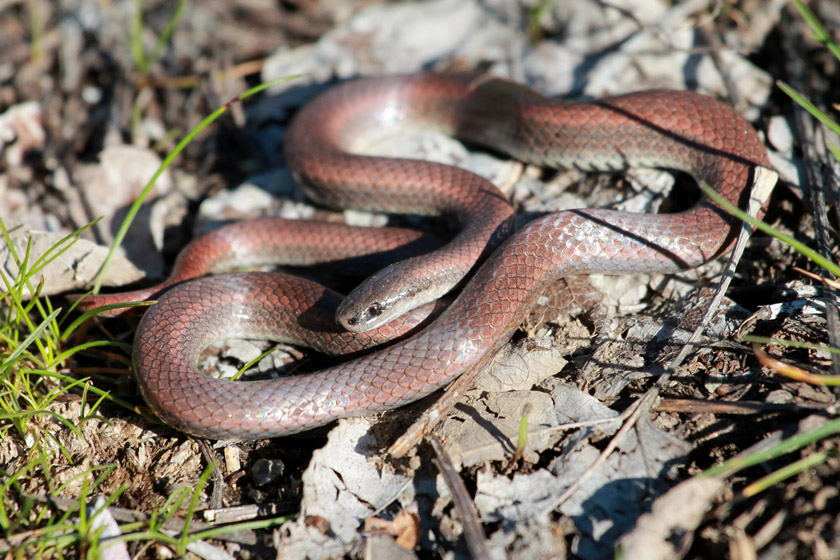
Getty: randimal
Sharp-tailed snakes never grow big or long; they top out at around 12-18 inches. Their distinguishing feature is a sharp, protruding tail scale. They use this adaptation to anchor prey while eating. Sharp-tailed snakes have smooth, shiny, gray or reddish-brown scales with bars of black, pale green, gray, or cream underneath. Some also have a yellow or red line along their upper sides.
Sharp-tailed snakes can be found on sunny days during the rainy season resting under objects in open areas such as boards, rocks, wood debris, gravel piles, or leaf litter. This secretive snake tends to spend much of its time under surface objects or underground.
A good burrower, the Sharp-tailed snake prefers a moister habitat since its usual prey is salamanders and even slugs. Sharp-tailed snakes include the Forest Sharp-tailed Snake and the Common Sharp-tailed Snake. The coloration of this nonvenomous snake is a rusty, brick-red, or orange-red adaptation.
California Kingsnake

Getty: yhelfman
All hail the king! These common snakes are kept widely as pets and highly regarded for their beautiful appearance. California kingsnakes are highly variable in appearance, but are commonly seen with alternating bands of black or brown and white or (light) yellow. The bands become wider on the underside.
California kingsnakes adapt to a variety of habitats, including forests, prairies, deserts and many other ecosystems. For this reason, kingsnakes occur in most of California, Baja California, and Arizona, including parts of Nevada and much of Sonora, Mexico. kingsnakes are powerful constrictors that are well known for being a predator of many small mammals, other reptiles, and especially rattlesnakes. They are immune to most snake venom and can hunt venomous snakes.
This nonvenomous species includes the common kingsnake and the Mountain kingsnake.
Western Yellow-Bellied Racer
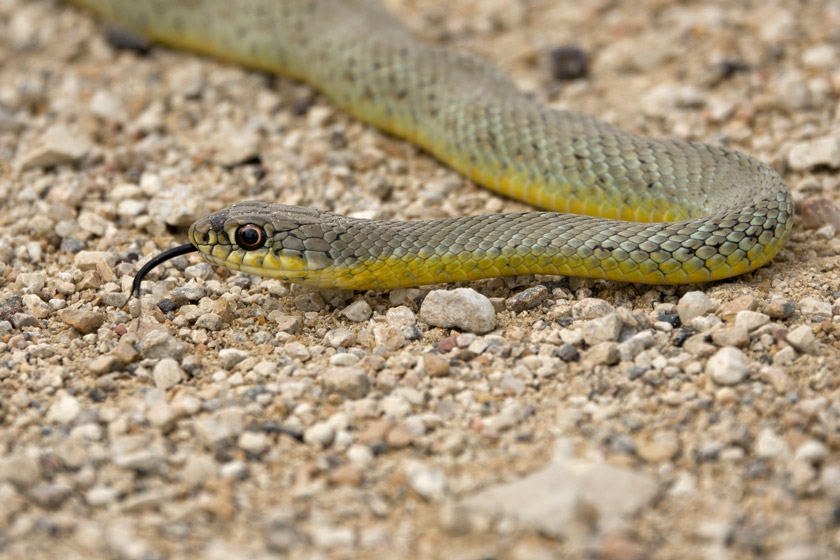
Getty: milehightraveler
Another nonvenomous snake, the Western yellow-bellied racer is a quick-moving ground snake, but is also known as a good climber. This species also eats other reptiles (including snakes), birds, eggs, and even frogs, but is sometimes known as an aggressive biter of people.
They are not usually found in the arid regions or in the mountains, but prefer grasslands and forest edges, especially areas that include ponds.
Striped Racer
The California striped racer (also known as the Chaparral whipsnake) are another in the line of long, slender, fast-moving snakes that inhabit grasslands, scrublands, and rocky hillsides. Adults can be 36-40 inches in length and a dark olive brown and gray with a pale yellow or cream colored solid stripe on each side that tapers down towards the tail.
The striped racer will eat rodents, birds, salamanders, and other small snakes, but it is especially fond of spiny lizards. This quick-moving snake is difficult to get close to, but if it feels threatened it will aggressively strike and bite any animal that bothers it. It is not considered dangerous to humans.
The two nonvenomous striped racers are the California striped racer and the more rare Alameda striped racer.
Ring-Necked Snake
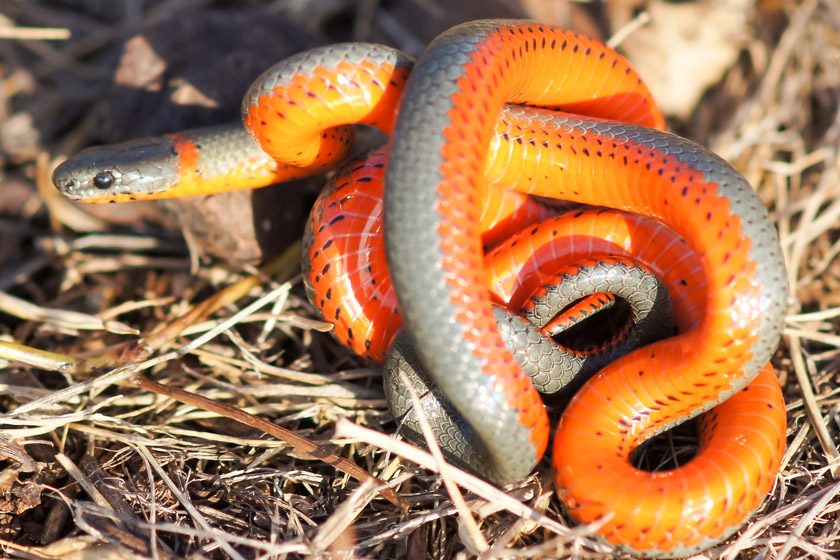
Getty: yhelfman
There are seven species of ring-necked snakes in the Golden State which are mostly found in moist habitats and absent from the deserts and drier regions. Each of these snake species is similar in appearance, with a ring around the neck, separating the darker head from a grayish to green body, sometimes with a yellow-orange belly.
As with the other members of the species they eat salamanders, frogs, other small snakes, and lizards. They are more secretive than other snakes, preferring to hide under the cover of rocks, tree bark, or other debris found in their home range.
The other types of ring-necked snakes include the Pacific ring-necked Snake, San Bernardino ring-necked snake, northwestern ring-necked snake, coral-bellied ring-necked snake, regal ring-necked snake, San Diego ring-necked snake, and the Monterey ring-necked snake.
Garter Snake
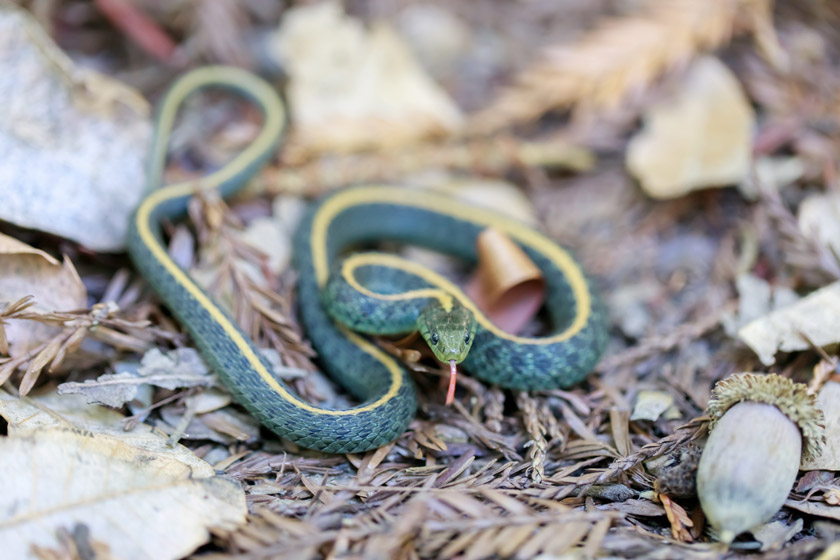
Getty: yhelfman
There are 14 subspecies of garter snakes (which are listed as water snakes) so it is not always easy to identify which one you have actually sighted. As a rule, most California garter snakes are medium-sized, slender snakes with a head not wider than the neck and scales on the back.
Garter snakes are generally found in a wide variety of habitats which range from sea level to high elevations. This includes forests, grasslands, and the native chaparral, particularly marshes, lakes, streams, ponds, and even in rocky creeks in the desert. It's said that the garter snakes are not venomous, but that they emit a mild toxin to help subdue their prey that is nonvenomous to most humans.
These are the different types of California garter snakes:
- Santa Cruz garter snake
- Oregon garter snake
- Diablo Range garter snake
- Sierra garter snake
- Mountain garter snake
- Coast garter snake
- Wandering garter snake
- Giant garter snake
- Two-striped garter snake
- Marcy's checkered garter snake
- Northwestern garter snake
- Valley garter snake
- California red-sided garter snake
- San Francisco garter snake
Western Rattlesnake
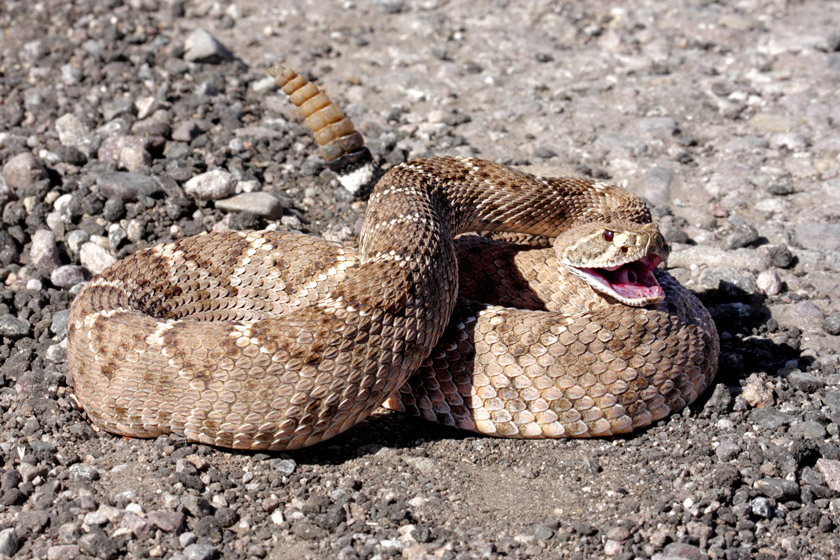
Getty: SteveByland
There are 10 members of the rattlesnake family listed for California. Probably the most well known of these is the western diamondback rattlesnake. The divots or "pits" on the front sides of its head distinguishes it as a pit viper.
All rattlesnakes that reside in California have a blotched pattern on their back and a rattle on the end of the tail which the snake sometimes uses as a warning sound. Most eat small mammals, birds, and lizards.
Here are the species of rattlesnakes founding California:
- Colorado Desert sidewinder
- Great Basin rattlesnake
- Mohave Desert sidewinder
- Northern Mohave rattlesnake
- Northern Pacific rattlesnake
- Panamint rattlesnake
- Red diamond rattlesnake
- Southern Pacific rattlesnake
- Southwestern speckled rattlesnake
- Western diamondback rattlesnake
Fun fact: according to Active Wild the western diamondback Rattlesnake is responsible for more snake bites in the United States than any other species.
In the larger view, only one of these snake species is harmful to humans, and only when cornered or threatened. Rattlesnake bites can be deadly, but can be avoided by taking simple steps, including being aware of your surroundings, avoiding startling or provoking a rattlesnake, and keeping a safe distance from a rattlesnake.
Good ID skills go a long way towards conserving the different species to ensure their survival and well being. Snakes like these have a very important role in their niches and in the environments in which they live and thrive.
California certainly has other, less common reptiles that reside inside its borders, but these are generally the most seen by residents, or simply the most well known due to their reputation. Now you've got a reference and resource the next time you want to identify one.
Looking for a little more or even hot lunch for your hunting blind? Follow my webpage, or on Facebook and YouTube.
